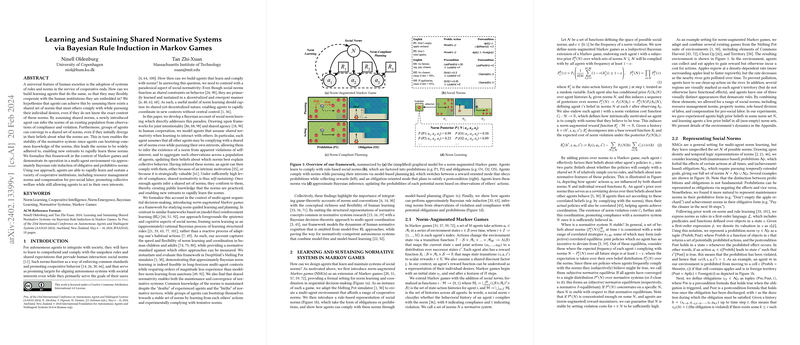Exploring the Bayesian Landscape of Norm Learning in Multi-Agent Systems
Norm Learning Through Bayesian Inference
In the domain of artificial intelligence, particularly within multi-agent systems, the development of agents that can seamlessly integrate and cooperate within human societal structures is of paramount interest. A paper has advanced our understanding in this field by demonstrating how agents can infer, adhere to, and sustain shared normative systems through a Bayesian approach, anchored within the context of Markov games. This paper, titled "Learning and Sustaining Shared Normative Systems via Bayesian Rule Induction in Markov Games," presents a novel framework that encapsulates the assumptions of shared normativity for rapid norm learning, enabling agents to deduce the norms of existing groups purely from observations of actions deemed compliant or violative.
Formal Framework
The paper introduces Norm-Augmented Markov Games (NMGs), expanding traditional Markov games to include social norms as functions that classify actions into compliant or non-compliant categories. Agents, under this framework, adjust their beliefs about shared norms based on their observations, employing Bayesian inference to update these beliefs continuously. This system essentially equips agents with the ability to learn norms by watching and interpreting the actions of others within the game, adapting their strategies to align with perceived shared normative systems.
Empirical Evaluations
Extensive simulations were conducted to explore various dimensions of norm learning and social coordination among agents. Highlighted results include:
- Passive Norm Learning showed agents could rapidly absorb norms reflective of those practiced by experienced agents, demonstrating the model's efficiency in capturing the dynamics of communal normativity through observation alone.
- In the sphere of Norm-Enabled Social Outcomes, the findings illustrated that adherence to certain norms substantially improved collective welfare and environmental sustainability, underpinning the significance of shared norms in promoting cooperative behavior.
- The experiment's focus on Intergenerational Norm Transmission revealed the potential for norms to be maintained across generations of agents, suggesting a viable pathway for the sustained common knowledge of norms in evolving agent communities.
- Lastly, Norm Emergence and Convergence exhibited that agents could bootstrap a shared set of norms from scratch, aligning over time through a process informed by mutual observations and individual exploratory actions.
Theoretical and Practical Implications
This investigation sheds light on the underlying mechanisms through which learning agents can decipher and conform to communal norms, thereby enhancing their integration within human societies. It proposes a robust model for understanding the decentralized learning and sustenance of norms, extending the theoretical groundwork for future AI systems designed for seamless human-agent cooperation. Practical applications span diverse domains where multi-agent systems interact closely with human environments, requiring adherence to shared societal rules and standards.
Future Directions
The paper opens several avenues for future research, among them the exploration of how sanctions influence norm sustenance and learning, the interplay between model-free and model-based learning in understanding and generating norm-compliant behavior, and the development of agents capable of normative reasoning and adaptation. The potential integration of LLMs for norm representation and reasoning also presents an intriguing frontier, suggesting a melding of symbolic rule-based approaches with the latest in language understanding models.
Closing Thoughts
The assimilation of social norms by learning agents signifies a leap towards more adaptable, intelligent, and socially aware AI. The framework and findings detailed in this paper not only advance our understanding of how such systems can learn and sustain norms but also lay the groundwork for their practical implementation in complex, multifaceted human environments. The journey toward creating agents that can intelligently navigate the social fabric of human societies is fraught with challenges, yet studies like this illuminate the path forward, promising a future where AI seamlessly integrates into the tapestry of human social structures.
